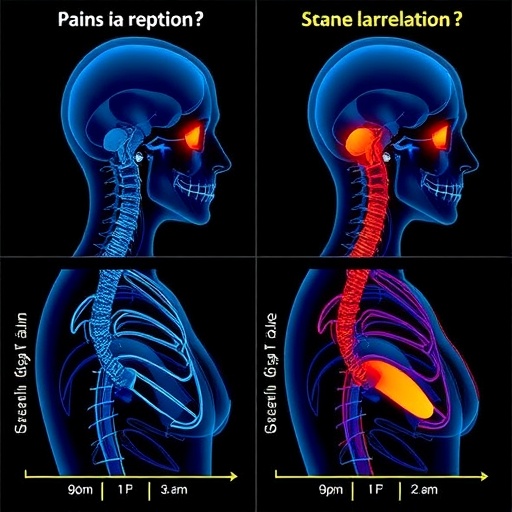Recent findings from a groundbreaking study reveal important insights into the complex relationship between pain and autonomic outflow, with a particular focus on sex differences during the cold pressor test. Conducted by a team of researchers led by L.A. Chaudhry, this investigation sheds light on how pain perception can vary significantly between males and females, offering potential implications for clinical practices and pain management strategies. This research highlights a critical area previously underexplored in the scientific field, emphasizing the need to consider sex as a fundamental biological variable when studying pain and autonomic responses.
In traditional pain research, the predominant focus has often been gender-neutral, assuming a uniform response to painful stimuli across all individuals. However, the findings of Chaudhry et al. challenge this assumption, indicating that physiological responses to pain can be markedly different when accounting for biological sex. Their research employed the cold pressor test—a widely utilized experimental procedure that involves submerging one hand in ice-cold water for a defined period—to induce acute pain while measuring participants’ autonomic outflow.
The autonomic nervous system plays a crucial role in how the body responds to stress and pain, comprising two branches: the sympathetic nervous system, which prepares the body for ‘fight-or-flight’ responses, and the parasympathetic nervous system, which promotes ‘rest-and-digest’ functions. By examining how these systems interact during painful stimuli, the researchers sought to understand the underlying mechanisms that contribute to the observed sex differences. Their approach involved a series of physiological measurements, including heart rate variability and blood pressure, which provided a comprehensive picture of autonomic function in response to pain.
The study’s findings indicate that males and females not only perceive pain differently but also exhibit divergent patterns of autonomic regulation when exposed to similar painful stimuli. Males demonstrated a more pronounced sympathetic response, characterized by heightened heart rates and reduced heart rate variability, which are typically associated with increased stress responses. In contrast, females exhibited a more balanced autonomic response, showcasing both sympathetic activation and parasympathetic engagement. This variation suggests that females may employ a more nuanced approach in coping with pain, potentially allowing for better regulation of physiological stress responses.
Moreover, the research highlights the importance of considering hormonal influences, particularly estrogen and progesterone, which play significant roles in pain modulation. These sex hormones can affect neural pathways involved in pain perception and autonomic regulation, thereby contributing to the observed differences in pain response. The cyclical nature of hormonal fluctuations in females could also result in variable pain perceptions across the menstrual cycle, raising further questions about the interplay between biological sex, hormonal status, and pain sensitivity.
The implications of these findings extend beyond academic interest; they suggest a potential reevaluation of pain management strategies. For instance, understanding that men and women might require different approaches to pain relief could lead to more effective treatment protocols tailored to individual needs. This research advocates for personalized medicine, where treatment plans are designed with the awareness of sex-based physiological differences in pain processing.
Furthermore, these results may pave the way for enhanced clinical assessments, ensuring that healthcare providers are equipped with the knowledge necessary to better understand their patients’ pain experiences. Training programs aimed at improving awareness of sex differences in pain perception could benefit medical professionals, ultimately leading to more empathetic and effective patient care.
The findings of Chaudhry and colleagues resonate in various areas beyond basic pain research. For instance, they pose important questions about the efficacy of commonly used analgesics and pain management techniques in different sexes. As varying responses to drugs based on biological sex are well-documented, integrating these findings into clinical practice could significantly improve patient outcomes in pain management.
These revelations also call attention to the importance of diversity in clinical trials and research studies. Historically, there has been an underrepresentation of female participants in pain research, leading to a knowledge gap that could inadvertently disadvantage women concerning pain diagnosis and treatment. Engaging a balanced cohort of male and female subjects in future research will be vital to achieving a more comprehensive understanding of pain mechanisms.
In conclusion, the examination of sex differences in pain response and autonomic outflow during induced pain provides compelling evidence that must be acknowledged within the scientific community and clinical practice. As the study by Chaudhry et al. unfolds its implications, it emphasizes the need for a paradigm shift in understanding pain—not just as a universal experience, but as a phenomenon influenced by biological sex. This work undoubtedly lays the groundwork for future explorations and potential breakthroughs in pain management, opening avenues for innovative and tailored approaches to improve quality of life for individuals suffering from chronic pain.
By recognizing and integrating these sex differences into research and clinical frameworks, we can move closer to achieving equitable and effective pain treatment strategies for all individuals, aligning with the principles of personalized medicine and patient-centered care.
Subject of Research: Pain perception and autonomic outflow variations based on sex during cold pressor test.
Article Title: Sex differences in the relationship between pain and autonomic outflow during a cold pressor test.
Article References:
Chaudhry, L.A., Coovadia, Y., Schwende, B.K. et al. Sex differences in the relationship between pain and autonomic outflow during a cold pressor test.
Biol Sex Differ 16, 60 (2025). https://doi.org/10.1186/s13293-025-00743-2
Image Credits: AI Generated
DOI:
Keywords: Sex Differences, Pain Perception, Autonomic Response, Cold Pressor Test, Pain Management, Biological Sex.




